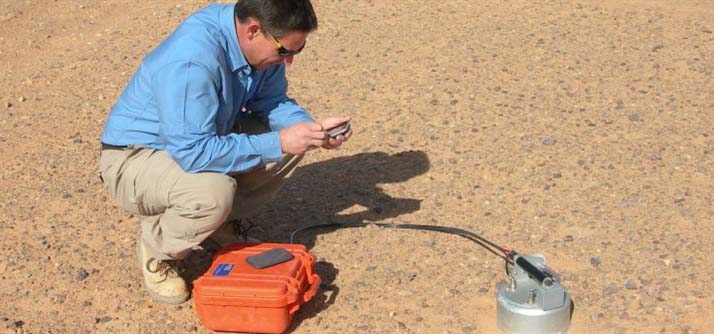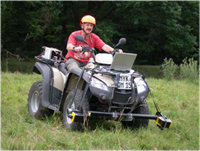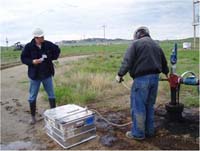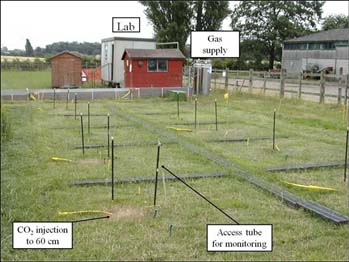> Monitoring a CO2 Storage Site:

CO2 storage regulations will require that storage operations are rigorously monitored for a number of reasons, including:
> verifying the amount and composition of CO2 being put into underground storage
> understanding how the
CO2 is behaving once underground
> providing early warning if things are not going as planned
> providing assurance of long–term storage integrity
> measuring any leakage that might occur
The most important public concern about CCS is whether stored CO2 will leak back to the surface (land or sea) and into the atmosphere. This would be a hazard because CO2 at high concentrations is an asphyxiant, but it would also mean that the process would not be working as a climate change mitigation method. However, for well-selected, designed and managed geological storage sites, the IPCC says that risks are low.
Monitoring will begin prior to injection to build up a baseline database for the site. A number of different monitoring techniques can be used and those chosen will be site dependent. Monitoring systems are characterised as deep focused and shallow focused.
Deep-focussed monitoring can be run from the surface (e.g. surface seismic or gravimetry) or from wellbores (e.g. well logging, pressure/temperature measurement) and is aimed at identifying and characterising changes that occur within the storage reservoir as injection proceeds, including the movement of CO2 within the storage reservoir and its immediate surroundings. Deep monitoring systems will also give early warning should CO2 migrate to shallower depths.
Shallow monitoring systems are designed to detect and measure CO2 that has migrated into shallow geological formations, to the soil or seabed, or leaked to the atmosphere or into seawater. Shallow focussed methods can be airborne (e.g satellite interferometry), deployed at the surface (e.g atmospheric measurements and surface flux), or can be run from shallow wellbores (e.g. geochemical sampling).
Monitoring Expertise at the NCCCS
Seismic - Experience from Sleipner
The Centre is among the organizations involved in monitoring and modelling the distribution of injected CO2 in the Utsira Sand to check that it is behaving as predicted and that it is not migrating out of the intended storage site.
3D seismic survey, showing acquisition vessel and subsurface ‘cube’ of data (Images courtesy of Statoil, Veritas and BP).
|

|
CO2 Atmospheric Monitoring
The Centre also uses a variety of equipment to monitor CO2 fluxes. This equipment includes atmospheric CO2 detectors which can be used on a static base or put on the front of vehicles’ to monitor over an area. This equipment is currently being used in experiments to investigate the impact of CO2 leaks on agricultural soils and crops.
A scientist using atmospheric CO2 detectors attached to the front of a vehicle to monitor an area.
|

|
Geochemistry
The Centre has expertise in monitoring using soil gases, utilising parameters such as CH4, CO2 temperature and pressure to identify leakage. The Centre has also carried out a number of isotopic studies on soil gases and water samples, utilising stable isotopes C and O and noble gases, He, Ne, Ar, Kr and Xe isotopic ratios and abundances.
Scientists collecting water samples for noble gas analysis.
|

|
Ecosystem Monitoring
The Centre has carried out a number of experiments on the effects of CO2 leakage on the ecosystem, including using specialised subsurface cameras to look at the effects on plant roots and organisms.
Study of Natural Analogues
The volcanic island of Panarea is characterized by the presence of continuous emission of volcanic gases from the seafloor. In November 2002 the system increased its flow of some order of magnitude and since then a steady release of gas is present generating bubble plumes that, in the shallowest points, reach the sea surface. The area has shallow water (less than 50m depth) and is close to the shore, making it an ideal site to be used as a “natural lab” to study the effect of high levels of CO2 on the marine environment by both surface techniques and directly by means of SCUBA diving. A researcher at the Centre has spent many hours diving in this area to collect samples of fluids and sediments and to study the biota. After a first phase of volcanic surveillance, the island has been more recently studied as a “natural analogue” for the development of reliable monitoring techniques for potential seepage from sub-seabed carbon storage sites.
|

|
Test Facilities at the University of Nottingham
Based at the University of Nottingham, ASGARD (Artificial Soil Gassing and Response Detection) is a specialist field facility designed to simulate such a leak so that ecosystem responses to CO2 can be assessed under controlled conditions. CO2 can be injected into the soil at a depth of 60cm and measurements of parameters such as gas concentrations and fluxes, isotopic signatures, soil moisture, root growth, and photosynthesis can be made.
|

|
Source: The Nottingham Centre for Carbon Capture and Storage
<< Previous page
TOP
|





